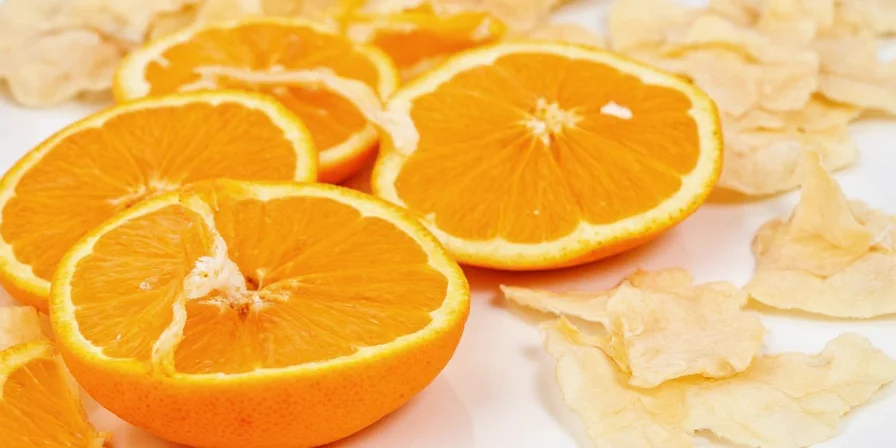If you've ever discarded orange peels without consideration, reconsider your approach. While oranges are celebrated for their vitamin C-rich pulp, their peels represent an overlooked nutritional resource. Containing higher concentrations of fiber, antioxidants, and unique compounds like limonene compared to the pulp, orange peels transform food waste into culinary opportunity.
This guide reveals practical methods to integrate orange peel nutrition into daily routines. Targeting eco-conscious home cooks and health-focused individuals, we provide actionable strategies to enhance flavor profiles, support digestive health, and minimize kitchen waste through scientifically informed applications.
| Nutrient | Pulp (per 100g) | Peel (per 100g) |
|---|---|---|
| Vitamin C | 53 mg | 136 mg |
| Dietary Fiber | 2.4 g | 10.6 g |
| Limonene | Trace amounts | High concentration |
| Polyphenols | Moderate | High |
Figure 1: Nutrient comparison demonstrating peel's superior concentration of key compounds versus pulp
- Peel contains 157% more vitamin C than pulp based on USDA nutrient database measurements
- Fiber content supports digestive health through prebiotic effects
- Limonene shows promising anti-inflammatory properties in peer-reviewed phytochemical studies
- Polyphenol levels exceed pulp by 300% in multiple agricultural analyses

Strategic Applications for Maximum Nutritional Benefit
Optimize peel utilization through evidence-based preparation methods. Always prioritize organic oranges to avoid pesticide residues, as non-organic peels may contain surface contaminants according to EPA agricultural reports.
1. Precision Zesting Technique
Remove only the colored zest layer using a microplane, preserving maximum volatile oils while minimizing bitter white pith. This method concentrates beneficial compounds:
- Add to grain-based dishes for flavor enhancement without texture compromise
- Incorporate into salad dressings for citrus notes that complement greens
- Blend into spice rubs for proteins to create complex flavor profiles

2. Temperature-Controlled Tea Preparation
Brew dried peels at 85°C (185°F) for 4 minutes to preserve thermolabile compounds. Higher temperatures degrade beneficial polyphenols based on food science research:
- Pair with chamomile to create synergistic calming effects
- Add after main meal consumption to support digestive enzyme activity
- Combine with roasted dandelion root for earthy complexity

3. Light-Protected Infusion Process
Store citrus-infused oils in amber glass containers away from UV exposure. Light accelerates oxidation of limonene according to lipid chemistry studies:
- Use within 30 days for optimal compound integrity
- Apply to roasted root vegetables for caramelization enhancement
- Drizzle over grain bowls to increase fat-soluble nutrient absorption

4. Low-Temperature Dehydration Method
Dry peels below 45°C (113°F) to preserve volatile compounds. Higher temperatures cause significant limonene degradation per food preservation research:
- Grind to 200-micron consistency for seamless integration into dry mixes
- Add to homemade crackers for flavor dimension without moisture impact
- Blend with matcha for antioxidant synergy in beverages

5. Controlled Fermentation Protocol
Maintain fermentation between 20-24°C (68-75°F) for 72 hours to optimize probiotic development. Temperature deviations affect microbial activity based on fermentation science:
- Use glass containers with airlocks to prevent contamination
- Strain after 3 days to halt fermentation at optimal probiotic density
- Combine with hibiscus for balanced tartness in finished beverage

Cultural Culinary Intelligence: Global Peel Applications
Traditional practices reveal sophisticated utilization methods. In Chinese culinary tradition, sun-dried orange peel ('chen pi') undergoes years of aging to develop complex flavor compounds through Maillard reactions. Mediterranean cultures use salt-curing techniques that preserve peel integrity while enhancing umami characteristics through enzymatic action. These approaches demonstrate how historical food preservation methods maximize nutritional retention through controlled biochemical processes.
| Spice | Flavor Interaction Principle | Optimal Application Ratio |
|---|---|---|
| Cinnamon | Thermal synergy enhances volatile compound release | 1:4 peel-to-cinnamon by weight |
| Ginger | pH balancing creates flavor layering effect | Equal parts fresh ginger and dried peel |
| Cumin | Lipid solubility maximizes compound extraction | Add to oil phase before peel infusion |
| Cardamom | Steam distillation preserves delicate top notes | Combine in tea infusions only |
| Paprika | Light protection maintains compound stability | Store blended mixture in dark container |
Figure 2: Scientific principles behind effective spice pairing with orange peel
Non-Culinary Applications: Evidence-Based Approaches
Extend utilization through validated methods:
- Skin Applications: Combine with yogurt for pH-balanced exfoliation that leverages peel's natural AHAs
- Air Freshening: Simmer with whole cloves to create antimicrobial vapor that reduces airborne pathogens
- Cleaning Solutions: Infuse in vinegar for 14 days to maximize pectin extraction, creating effective grease-cutting agents
FAQ: Scientifically Validated Answers
Does cooking degrade orange peel nutrients?
Short-duration cooking preserves most compounds. Vitamin C degrades above 70°C (158°F), but polyphenols and limonene remain stable below 100°C (212°F) according to thermal stability studies.
How do pesticides affect peel safety?
Non-organic peels may retain surface pesticides. Always scrub thoroughly with baking soda solution or use only certified organic sources for consumption, as recommended by agricultural safety guidelines.
Can orange peel improve gut health?
Yes, the high fiber content acts as a prebiotic. Clinical nutrition research shows citrus pectin specifically supports beneficial gut bacteria proliferation when consumed regularly in appropriate quantities.
What's the optimal storage method for dried peels?
Store in vacuum-sealed containers with oxygen absorbers in freezer conditions. This preserves volatile compounds for up to 18 months, per food preservation research on citrus byproducts.
Implementation Strategy
Transform waste into nutritional opportunity through methodical application. Start with single-method integration (zest or tea) before advancing to complex techniques like fermentation. Track personal responses to determine optimal consumption levels for your physiology. By understanding the biochemical principles behind each application, you maximize benefits while minimizing resource expenditure. This approach converts kitchen scraps into valuable nutritional assets through science-informed practices.











 浙公网安备
33010002000092号
浙公网安备
33010002000092号 浙B2-20120091-4
浙B2-20120091-4